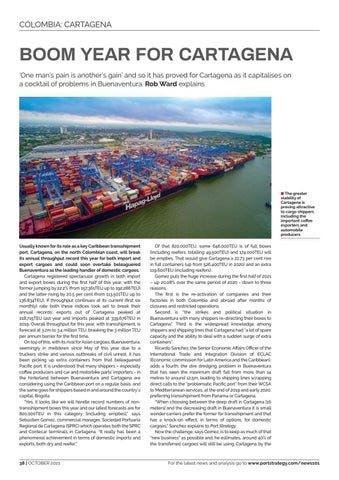COLOMBIA: CARTAGENA
BOOM YEAR FOR CARTAGENA ‘One man’s pain is another’s gain’ and so it has proved for Cartagena as it capitalises on a cocktail of problems in Buenaventura. Rob Ward explains
8 The greater stability of Cartagena is proving attractive to cargo shippers including the important coffee exporters and automobile producers
Usually known for its role as a key Caribbean transshipment port, Cartagena, on the north Colombian coast, will break its annual throughput record this year for both import and export cargoes and could soon overtake beleaguered Buenaventura as the leading handler of domestic cargoes. Cartagena registered spectacular growth in both import and export boxes during the first half of this year, with the former jumping by 22.2% (from 157,361TEU up to 192,286TEU) and the latter rising by 20.5 per cent (from 113,501TEU up to 136,834TEU). If throughput continues at its current (first six monthly) rate both these indices look set to break their annual records: exports out of Cartagena peaked at 218,715TEU last year and imports peaked at 339,676TEU in 2019. Overall throughput for this year, with transshipment, is forecast at 3.2m to 3.4 million TEU, breaking the 3 million TEU per annum barrier for the first time. On top of this, with its rival for Asian cargoes, Buenaventura, seemingly in meltdown since May of this year due to a truckers strike and various outbreaks of civil unrest, it has been picking up extra containers from that beleaguered Pacific port. It is understood that many shippers – especially coffee producers and car and motorbike parts’ importers - in the hinterland between Buenaventura and Cartagena are considering using the Caribbean port on a regular basis, and the same goes for shippers based in and around the country`s capital, Bogota. “Yes, it looks like we will handle record numbers of nontransshipment boxes this year and our latest forecasts are for 820,000TEU in this category [including empties],” says Sebastien Gomez, commercial manager, Sociedad Portuaria Regional de Cartagena (SPRC) which operates both the SPRC and Contecar terminals in Cartagena. “It really has been a phenomenal achievement in terms of domestic imports and exports, both dry and reefer.”
38 | OCTOBER 2021
Of that 820,000TEU, some 646,000TEU is of full boxes (including reefers, totalling 49,500TEU) and 174,000TEU will be empties. That would give Cartagena a 22.73 per cent rise in full containers (up from 526,400TEU in 2020) and an extra 119,600TEU (including reefers). Gomez puts the huge increase during the first half of 2021 – up 20.08% over the same period of 2020 - down to three reasons. The first is the re-activation of companies and their factories in both Colombia and abroad after months of closures and restricted operations. Second is “the strikes and political situation in Buenaventura with many shippers re-directing their boxes to Cartagena”. Third is the widespread knowledge among shippers and shipping lines that Cartagena had “a lot of spare capacity and the ability to deal with a sudden surge of extra containers”. Ricardo Sanchez, the Senior Economic Affairs Officer of the International Trade and Integration Division of ECLAC (Economic commission for Latin America and the Caribbean), adds a fourth; the dire dredging problem in Buenaventura that has seen the maximum draft fall from more than 14 metres to around 12.5m, leading to shipping lines scrapping direct calls to the “problematic Pacific port” from their WCSA to Mediterranean services, at the end of 2019 and early 2020, preferring transshipment from Panama or Cartagena. “When choosing between the deep draft in Cartagena [16 meters] and the decreasing draft in Buenaventura it is small wonder carriers prefer the former for transshipment and that has a knock-on effect, in terms of options, for domestic cargoes,” Sanchez explains to Port Strategy. Now the challenge, says Gomez, is to keep as much of that “new business” as possible and, he estimates, around 40% of the transferred cargoes will still be using Cartagena by the
For the latest news and analysis go to www.portstrategy.com/news101











